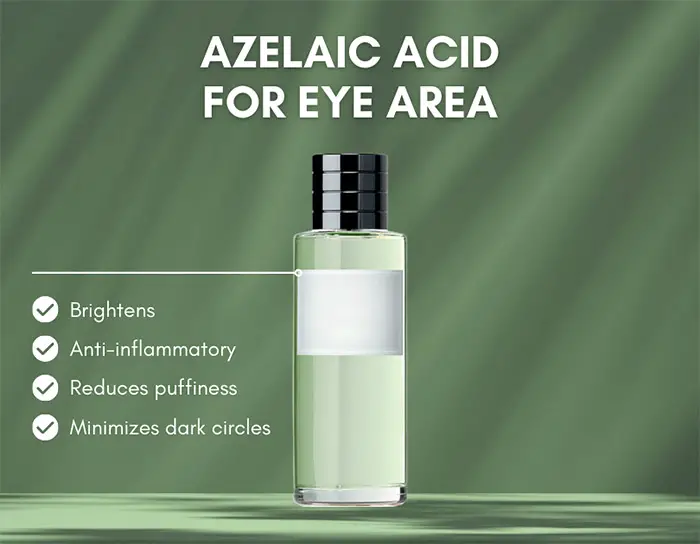
Azelaic acid, known for treating acne, hyperpigmentation, and rosacea, is also a wonder for under eyes. However, many people are still unsure of whether it is safe to use azelaic acid around their eyes. In this blog post, we will explore the benefits of using azelaic acid for dark circles, under-eye bags, and other eye-related issues, as well as its potential side effects.
Table of Contents
- Is Azelaic Acid Safe for Use Around the Eyes?
- Brightening Effects: Azelaic Acid for Dark Circles
- Azelaic Acid for Eye Bags
- The Promising Role of Azelaic Acid for Eyebrows
- How to Apply Azelaic Acid to the Eye Area
- Potential Side Effects of Azelaic Acid on the Eyes
Is Azelaic Acid Safe for Use Around the Eyes?
Azelaic acid is widely regarded as safe for application around the eyes. Thanks to its brightening properties, derived from its tyrosinase-inhibiting capabilities, this active ingredient, may help manage dark circles and reduce puffiness.
Moreover, azelaic acid possesses anti-inflammatory properties that soothe and decongest the eye area, promoting better blood circulation and reducing puffiness.
Brightening Effects: Azelaic Acid for Dark Circles
Dark circles under the eyes are caused by numerous factors which run from genetic predisposition to sun exposure, lack of sleep, deep eye sockets, etc. While genetic factors are irreversible, dark circles caused by sun exposure, allergies, dry or dehydrated skin, or frequent rubbing may be improved.
Azelaic acid’s ability to combat dark under-eye circles is attributed to its melanin-inhibiting property. Melanin, the pigment responsible for our skin color, can cause hyperpigmentation when overproduced, including under-eye circles.
A study published in the Journal of Clinical and Aesthetic Dermatology suggests that azelaic acid can be beneficial in managing hyperpigmentation disorders, thus it may help lighten dark circles.

Azelaic Acid for Eye Bags
The area around the eyes can become puffy due to fluid retention, inflammation, aging, high-salt diets, lack of sleep, medical conditions, or genetics.
Azelaic acid, with its anti-inflammatory properties, can help mitigate such puffiness.
Also, its mild exfoliating properties can help reveal younger and tighter skin in the under-eye area. However, its effectiveness may vary, hence consulting a dermatologist for personalized advice is recommended.
The Promising Role of Azelaic Acid for Eyebrows
In certain conditions, azelaic acid may stimulate eyebrow growth. For instance, in androgen alopecia, it could help prevent eyebrow hair loss due to its capacity to inhibit the 5-α-reductase enzyme, which disrupts hair growth.
Moreover, azelaic acid can alleviate inflammation and exfoliate the affected area in cases of psoriasis, promoting ideal conditions for healthy hair growth.
Psoriasis is a condition where skin cells multiply rapidly, leading to the formation of large, scaly patches on the skin. These patches can block hair follicles, thereby preventing hair growth and causing hair loss.
Azelaic acid, with its anti-inflammatory and exfoliating properties, can aid in reducing the inflammation and scales associated with psoriasis. By doing so, it helps unblock the hair follicles, paving the way for healthier and unrestricted hair growth.
Azelaic acid also exhibits antimicrobial properties, which can help in managing folliculitis, an inflammatory condition that affects hair follicles.
Folliculitis often results in damaged hair and can negatively impact the health and thickness of the eyebrows. By mitigating this inflammation, azelaic acid can promote healthier hair follicles, leading to improved eyebrow health and thickness.
Despite the potential benefits, the application of azelaic acid on eyebrows should be carried out under professional guidance. Its effects can vary among individuals, and it’s essential to ensure that its usage aligns with an individual’s specific skin needs and conditions.
How to Apply Azelaic Acid to the Eye Area
Azelaic acid should be applied cautiously around the eyes, avoiding direct contact to prevent potential irritation.
Apply a small amount around the orbital bone, keeping it away from the eyelids and immediate under-eye area.
If found in a rinse-off product, make sure to apply just under your eyes and avoid any contact with your eyes.
If found in a cream, serum, or lotion form, apply a small amount and pat gently under your eyes until the product is fully absorbed.
Can You Use Azelaic Acid on Your Eyelids?
Azelaic acid should not be directly applied to the eyelids. The skin on the eyelids is thinner and more sensitive than the rest of the face and may become irritated with azelaic acid application.
Potential Side Effects of Azelaic Acid on the Eyes
While generally well-tolerated, azelaic acid can have certain side effects when applied around the eye area:
- Mild burning or irritation, especially in sensitive areas like the eye
- Dryness and flakiness on the area applied.
If azelaic acid comes into contact with your eyes, rinse immediately with water. If irritation persists, seek medical attention. As always, consult a doctor before starting any new skincare regimen, especially when treating the delicate eye area.
In Conclusion
Azelaic acid presents promising potential for treating common eye-related issues such as dark circles and puffiness, in addition to promoting eyebrow health. However, like any skincare product, it should be used judiciously and under professional guidance to ensure safety and effectiveness. As research in this field evolves, we can look forward to further insights into the potential benefits and applications of azelaic acid in skincare.

Petra Nakashian (previously Kravos) is a dedicated natural health and beauty blogger, driven by the loss of her parents to cancer, which led her to meticulously research beauty product ingredients. With over 10 years of experience, her in-depth knowledge has made her a trusted expert in the field. Founder of Be Healthy Now and Green Beauty Talk, Petra recently expanded her expertise with Beauty Insights Hub, exploring a wider range of beauty treatments. Committed to transparency and honesty, her work is a vital resource for navigating the complex world of beauty.

